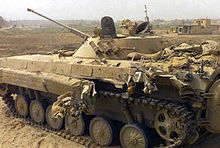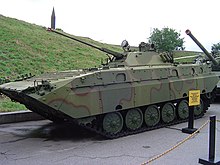BMP-2
During its combat debut in the 1973 Arab-Israeli War, Egyptian and Syrian BMPs proved vulnerable to .50 calibre machine-gun fire in the sides and rear, and to 105 mm M40 recoilless rifles.
The 2A28 Grom proved inaccurate beyond 500 metres, and the 9M14 Malyutka missile could not be guided effectively from the confines of the turret.
These lessons, combined with observations of western AFV developments, resulted in a replacement project for the original BMP in 1974.
The most significant changes are: In the centre of the vehicle is the welded steel turret, which seats the commander and gunner, both of whom have hatches.
The gunner sits to the commander's left and has a smaller rectangular hatch with a rearward-facing day periscope.
In the BMP-1 and BMP-2, ammunition is stored near or even inside the compartment, which can lead to a catastrophic failure in case of a hull breach.
Peacetime regulations require that any BMPs entering water must have a working radio set, since its bearings are not airtight and it can be carried away by currents in case of loss of engine power (the vehicle lacks an anchor).
Combined with the high maximum elevation of 74 degrees, it allows the 30 mm cannon to be used effectively against helicopters and slow flying aircraft.
The cannon is normally only used on the slow rate of fire, otherwise, fumes from the weapon would build up in the turret faster than the extractor fan can remove them.
The one-man-turret fighting vehicle seated its driver and commander in tandem layout, in the front-left side of the hull alongside the diesel engine.
[citation needed] When it subsequently detonated, the blast usually killed both the driver and the vehicle commander.
This shortcoming was addressed in the BMP-2 design, where the tank commander shares the well-armoured two-man turret with the gunner.
One important modification carried out as the result of operational experience in Afghanistan was the fitting of a second layer of stand-off armor, usually a high resistant ballistic rubber-like material, to act as spaced armour around the top of the hull sides and around the turret.
According to Russian sources, the vehicles repaired as of November 2023 are equipped with attachments to install additional protection kits.
[8] In the Soviet Army, BMPs were typically issued to the motor rifle battalions of tank regiments.
Since obtaining a sufficient number of BWP-2 vehicles after the political changes of 1989 became impossible, Poland was forced to abandon this plan.















